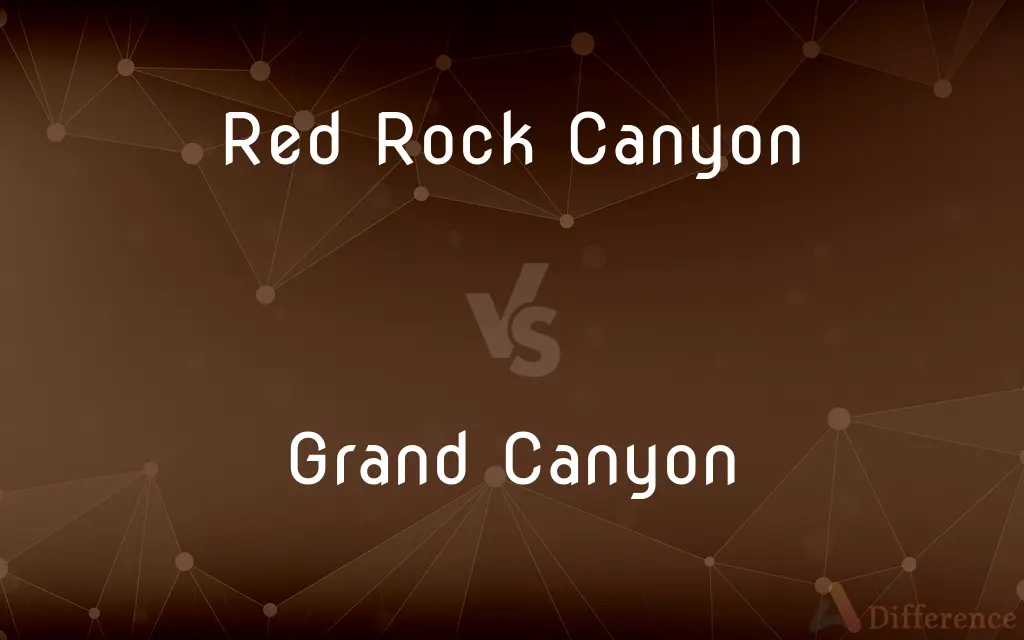Red Rock Canyon vs. Grand Canyon — What's the Difference?
By Tayyaba Rehman — Published on October 22, 2023
Red Rock Canyon is a smaller conservation area known for its red rock formations, while the Grand Canyon is a vast, deeper canyon known for its layered bands of colorful rock.

Difference Between Red Rock Canyon and Grand Canyon
Table of Contents
ADVERTISEMENT
Key Differences
Red Rock Canyon and Grand Canyon are two distinct geological wonders found in the United States, offering unique and spectacular landscapes. Red Rock Canyon, located near Las Vegas, Nevada, is smaller, characterized by vibrant red rock formations and is recognized as a conservation area providing a range of recreational activities. In contrast, the Grand Canyon, located in Arizona, is a vast, expansive canyon known for its striking, colorful layers of rock, revealing millions of years of geological history and is considered one of the Wonders of the World.
Red Rock Canyon is easily accessible and is frequently visited for day trips, particularly by those staying in Las Vegas. It offers a plethora of outdoor activities such as hiking, climbing, and biking amidst its radiant, distinctive rock formations. The Grand Canyon, on the other hand, is more remote and extensive, offering a variety of viewpoints, hiking trails, and river rafting opportunities in the Colorado River running through it, attracting visitors who often stay for multiple days to explore its depth and breadth.
The geological formations of Red Rock Canyon are largely composed of red, pink, and orange colored sandstone, providing scenic landscapes and photographic opportunities. Conversely, the Grand Canyon's geological formations are varied and extensive, displaying a multitude of colors and rock types, formed over millions of years through erosion by the Colorado River, offering a more complex and diverse geological experience.
The environment and ecosystems found within Red Rock Canyon are typical of the Mojave Desert, housing various desert flora and fauna, and providing a snapshot of desert ecology. The Grand Canyon, by contrast, encompasses a range of ecosystems from desert to alpine conditions due to its significant variations in elevation, hosting a broader range of plant and animal species and offering a more diversified ecological experience.
Comparison Chart
Location
Near Las Vegas, Nevada
Arizona
ADVERTISEMENT
Size
Smaller, conservation area
Larger, national park, one of the Wonders of the World
Accessibility
Easily accessible for day trips
More remote, extensive, often visited for multiple days
Geology
Primarily red sandstone formations
Varied, colorful layered rocks, deeper, and more complex
Ecosystems
Mojave Desert flora and fauna
Diverse, from desert to alpine conditions
Compare with Definitions
Red Rock Canyon
Red Rock Canyon is smaller and is suitable for day trips offering various recreational activities.
Tourists often visit Red Rock Canyon for hiking and climbing experiences amidst its stunning landscapes.
Grand Canyon
The Grand Canyon is renowned for its breathtaking views, extensive hiking trails, and river rafting opportunities.
The myriad of viewpoints and activities at the Grand Canyon make it a sought-after destination for adventurers.
Red Rock Canyon
Red Rock Canyon houses flora and fauna typical of the Mojave Desert.
While exploring Red Rock Canyon, visitors can encounter a variety of desert-adapted species.
Grand Canyon
The Grand Canyon is a vast, colorful canyon in Arizona, considered one of the Wonders of the World.
The Grand Canyon’s immense scale and colorful layered rocks draw millions of visitors annually.
Red Rock Canyon
Red Rock Canyon is a conservation area near Las Vegas known for its distinctive red rock formations.
The vibrant landscapes of Red Rock Canyon attract photographers and nature enthusiasts alike.
Grand Canyon
The Grand Canyon offers diverse ecosystems due to variations in elevation and climate.
Visitors to the Grand Canyon can experience ecosystems ranging from desert landscapes to alpine conditions.
Red Rock Canyon
Red Rock Canyon is characterized by its accessible, striking, and vibrant geological formations.
The spectacular views of red, pink, and orange sandstone are distinctive features of Red Rock Canyon.
Grand Canyon
The Grand Canyon reveals millions of years of geological history through its layered rocks.
The geological complexities of the Grand Canyon provide insights into Earth’s evolutionary history.
Red Rock Canyon
Red Rock Canyon is a popular destination for outdoor enthusiasts offering a snapshot of desert ecology.
The conservation initiatives at Red Rock Canyon help preserve its unique desert ecosystems.
Grand Canyon
The Grand Canyon is more remote and extensive compared to Red Rock Canyon, providing a diverse and rich experience.
The Grand Canyon’s remote expansiveness offers a multifaceted experience for explorers seeking depth and diversity.
Common Curiosities
Where is Red Rock Canyon located?
Red Rock Canyon is located near Las Vegas, Nevada.
Does the Grand Canyon offer diverse ecosystems?
Yes, the Grand Canyon hosts a range of ecosystems from desert to alpine conditions due to its variations in elevation.
Where is the Grand Canyon situated?
The Grand Canyon is situated in Arizona.
Is the Grand Canyon considered one of the Wonders of the World?
Yes, the Grand Canyon is considered one of the Wonders of the World due to its immense scale and geological significance.
Is Red Rock Canyon known for its distinctive geological formations?
Yes, Red Rock Canyon is renowned for its distinctive, vibrant red rock formations.
Which is larger, Red Rock Canyon or the Grand Canyon?
The Grand Canyon is significantly larger than Red Rock Canyon.
Can Red Rock Canyon be visited for a day trip?
Yes, Red Rock Canyon is easily accessible and is suitable for day trips, especially from Las Vegas.
Which canyon is more suitable for hiking and outdoor activities?
Both canyons offer hiking and outdoor activities, but the Grand Canyon provides a more extensive range of options due to its size and diversity.
Share Your Discovery

Previous Comparison
Financial Accounting vs. Management Accounting
Next Comparison
Web Server vs. Database ServerAuthor Spotlight
Written by
Tayyaba RehmanTayyaba Rehman is a distinguished writer, currently serving as a primary contributor to askdifference.com. As a researcher in semantics and etymology, Tayyaba's passion for the complexity of languages and their distinctions has found a perfect home on the platform. Tayyaba delves into the intricacies of language, distinguishing between commonly confused words and phrases, thereby providing clarity for readers worldwide.
















































